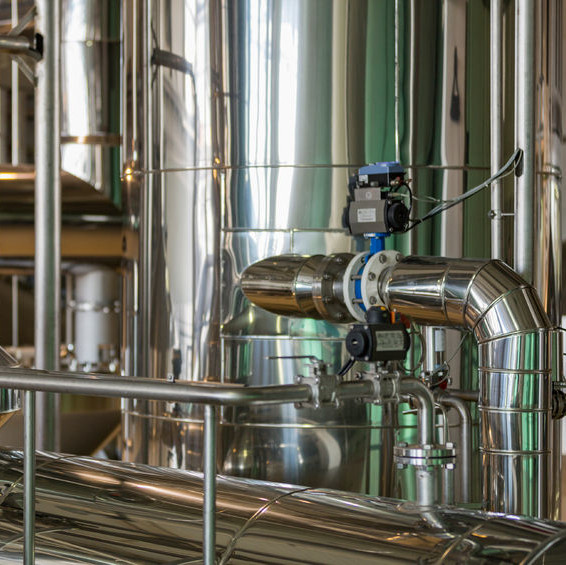
Clean-in-Place (CIP)
What is Clean-In-Place?
Clean-in-place (CIP) is a cleaning method widely used in the food, dairy, pharmaceutical, brewing and winemaking industries that require the highest standards of plant hygiene.
CIP implies cleaning equipment and its parts without disassembling them. CIP methods can include:
- Soaking/agitation systems
- Solvent refluxing
- High-impact spray-cleaning
- Turbulent flow systems.1
It is specifically designed for equipment which depends on circulating pumped water containing a sanitizing solution at relatively high velocities or turbulent volumetric flows for a specified time and temperature into the interior surfaces of closed equipment.
Origin
CIP was first developed for cleaning dairy pipelines by Dale A. Seiberling in the 1950s. At that time, closed equipment and liquid transport systems used in the process industry were disassembled, brushed, and cleaned manually. This was indeed a time consuming and exhausting task; downtime was long and the associated operational costs were high.2
CIP systems were the answer developed by industry professionals for most of the cleaning and sanitizing problems and challenges encountered in plants those days. In the 1960s increasing food safety requirements by the FDA and consumers concerns triggered developments in the design and construction of CIP systems that included tanks and heat exchangers, among other things.2
How does CIP work?
A typical CIP cycle consists of 8 basic steps:3
- Pre-rinse/washing
- Detergent circulation (removal of some of the remaining soil, usually involving heat). This step may be replaced by alkali cleaning
- Intermediate rinse
- Additional detergent circulation or acid cleaning
- Additional intermediate rinse (rinse off the acid and the inorganic soil)
- Sanitizing/disinfectant rinse (reduce any remaining microorganisms to an acceptable level)
- Final rinse (removal of the disinfectant to leave only a residue of fresh potable water)
- Drain
The time for rinse and wash cycles varies from five minutes to one hour. To ensure product quality, operators must use the appropriate amounts of cleaning solutions and make sure those solutions have been removed completely before the next processing run.
The components of a CIP system are:
- Storage and recirculation tanks
- Supply pump (centrifugal or positive displacement)
- Piping for connection of pieces of equipment
- Valves and fittings for controlling flow
- Heat exchangers
- Water addition assembly (e.g., spray nozzles)
Application
In commercial or high-speed baking plants, CIP systems are widely used for processing and handling liquid ingredients and liquid dough systems.
Due to economies of scale and high volumes, bakeries often use cream yeast (a creamy, pumpable liquid) for the production of yeast-leavened products such as pan bread and buns. Baking plant receives the yeast cream in an insulated tank truck. Upon arrival, it is stored in a pre-sanitized, refrigerated tank or silo. After emptying the cream yeast tank, the system, both the pipeline and storage vessels are automatically cleaned-in-place.4
Water, liquid shortening and liquid sugar handling equipment can also be cleaned-in-placed. The situation here depends on the design and construction of the equipment, degree of hygiene required (i.e., closed or open equipment), size of batches produced daily, storage capacity, and heating needs for keeping fats pumpable.5
In liquid pre-fermentation systems, also known as liquid sponges, brews, or broths, the equipment units involved can be cleaned-in-placed. Fermentation tanks, heat exchanger, supply and recirculation pumps, and holding tanks can be washed and sanitized by using CIP.
As for continuous mixers, both the premixer and developer can be either cleaned-in-place or cleaned-out-of-place, depending on their design, construction and supplier recommendations. Since there is a high flour ratio in the mixer, there is a chance that dough adhering to the interior surfaces is not completely removed by CIP. Such cases may call for different or combined cleaning procedures.
Systems that can be cleaned-in-place include equipment, accessories, and fittings:
- Piping
- Valves
- Pumps
- Filters
- Augers or dough pumps
- Storage vessels
- Heat exchangers (e.g., tubular, plate)
The main advantages CIP systems include:
- Cleaning efficiency
- Improved operator’s safety
- Shorter downtime and setup time
- Reduction or elimination of cross contamination
- Money savings in labor
One major drawback of CIP its high water usage and large waste water production. In order to attain the degree of turbulence required for efficient cleaning, CIP systems operate at very high flow rates.
References
- Hui, Y.H. “Cleaning and Sanitizing a Food Plant” Plant Sanitation for Food Processing and Food Service, Taylor & Francis Group, LLC, 2015, pp. 347–352.
- Fan, Mengyuan. “EFFECTIVENESS OF PRE-RINSE DURING IN-PLACE CLEANING OF STAINLESS STEEL PIPE LINES.” Electronic Thesis or Dissertation. Ohio State University, 2014. OhioLINK Electronic Theses and Dissertations Center. 15 May 2018.
- Stanga, M. “CIP (Cleaning in Place)” Sanitation Cleaning and Disinfection in the Food Industry, WILEY-VCH Verlag GmbH & Co. KGaA, Weinheim, 2010, pp. 301–315.
- AIB International. “Yeast and Fermentation”. Science of Baking Correspondence Course, Module II Ingredient Technology (2001), pp. 5–6. Manhattan, KS.
- AIB International. “Bakery Design and Layout”. Science of Baking Correspondence Course, Module I Foundations (2001), pp. 15–17. Manhattan, KS.

